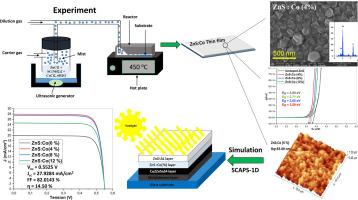高效太阳能电池共掺杂ZnS缓冲层的实验与数值研究
IF 4.3
Q2 CHEMISTRY, PHYSICAL
引用次数: 0
摘要
本研究探讨了钴(Co)掺杂浓度对硫化锌(ZnS)薄膜结构、形态、光学和电学性能的影响。采用经济、可扩展的超声辅助化学气相沉积(Mist CVD)技术,在450°C的衬底温度下成功地在玻璃衬底上沉积了未掺杂和共掺杂的ZnS薄膜。利用x射线衍射、拉曼光谱、扫描电子显微镜、原子力显微镜、紫外可见分光光度法和霍尔效应测量进行了全面的表征。为了评估其器件相关性,将ZnS:Co作为薄膜太阳能电池的缓冲层进行了SCAPS-1D模拟。结果表明,4%的Co掺杂提高了光电性能,达到了14.50%的最高模拟效率。这些发现表明,可控Co掺入是一种很有前途的途径,可以将ZnS薄膜定制为光伏器件中的高效缓冲层。本文章由计算机程序翻译,如有差异,请以英文原文为准。

Experimental and numerical insights into Co-doped ZnS buffer layers for high-efficiency solar cells
This study explores the influence of cobalt (Co) doping concentration on the structural, morphological, optical, and electrical properties of zinc sulfide (ZnS) thin films. Both undoped and Co-doped ZnS thin films were successfully deposited on glass substrates using an economical and scalable ultrasonic-assisted chemical vapor deposition (Mist CVD) technique at a substrate temperature of 450 °C. A comprehensive characterization was performed using X-ray diffraction, Raman spectroscopy, scanning electron microscopy, atomic force microscopy, UV–Vis spectrophotometry, and Hall effect measurements. To assess their device relevance, SCAPS-1D simulations were performed by incorporating ZnS:Co as buffer layers in thin-film solar cells. The results show that 4 % Co doping enhances the optoelectronic properties and achieves the highest simulated efficiency of 14.50 %. These findings demonstrate that controlled Co incorporation is a promising route for tailoring ZnS thin films toward efficient buffer layers in photovoltaic devices.
求助全文
通过发布文献求助,成功后即可免费获取论文全文。
去求助
来源期刊

Chemical Physics Impact
Materials Science-Materials Science (miscellaneous)
CiteScore
2.60
自引率
0.00%
发文量
65
审稿时长
46 days
 求助内容:
求助内容: 应助结果提醒方式:
应助结果提醒方式:


